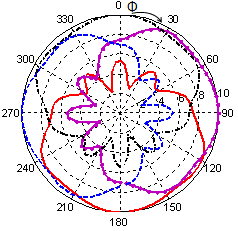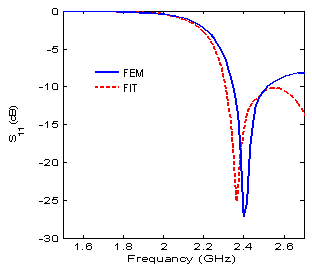-
Paper Information
- Next Paper
- Paper Submission
-
Journal Information
- About This Journal
- Editorial Board
- Current Issue
- Archive
- Author Guidelines
- Contact Us
International Journal of Electromagnetics and Applications
p-ISSN: 2168-5037 e-ISSN: 2168-5045
2012; 2(6): 140-144
doi: 10.5923/j.ijea.20120206.01
Hemispherical Dielectric Resonator Antennas over Non-Planar Surfaces for Direction Finding Systems
S. H. Zainud-Deen 1, Noha A. El-Shalaby 2, K. H. Awadalla 1
1Faculty of Electronic Engineering, Menoufia University, , Menoufia, Postcode, Egypt
2Faculty of Engineering, Kafrelsheikh University, Kafrelsheikh, Postcode, Egypt
Correspondence to: Noha A. El-Shalaby , Faculty of Engineering, Kafrelsheikh University, Kafrelsheikh, Postcode, Egypt.
| Email: |  |
Copyright © 2012 Scientific & Academic Publishing. All Rights Reserved.
In this paper, hemispherical DRA array mounted on or embedded in a hollow circular cylindrical ground structure is used for direction finding systems. In the proposed array only one DRA element is active and the others are parasitic. The direction of the received signal will be determined by the relation between the received signal strengths at each element of the array.
Keywords: DRA, SPA, PE, FEM, FIT, PDE
Cite this paper: S. H. Zainud-Deen , Noha A. El-Shalaby , K. H. Awadalla , "Hemispherical Dielectric Resonator Antennas over Non-Planar Surfaces for Direction Finding Systems", International Journal of Electromagnetics and Applications, Vol. 2 No. 6, 2012, pp. 140-144. doi: 10.5923/j.ijea.20120206.01.
1. Introduction
- Switched beam array can be used in a lot of communication applications such as base station tracking in mobile communication, wireless networking, motor vehicles, aircrafts, robots, radar, security systems, and detection of transmitter direction as needed in direction finding systems. In[1], a switched parasitic array (SPA) is considered by using parasitic elements (passive elements, PE) that can be shorted to ground by pin-diodes. The array is consisting of one fed element and several other parasitic elements. Switching between different identical patterns but pointing to different directions can be achieved using a coordinated shortening of the passive elements. Beam steering that is affected by mechanical steering, require complex feeding network, high power to operate, and its angular resolution is related to the beamwidth of the antenna. That can be achieved in crossed loop arrays, a highly directional arrays and phased arrays. But controlled directional patterns with electronically steerable beam are more efficient and useful. The control of the position of the feed element in an array to change the direction of its beam reduces multipath fading and power consumption through increased antenna gain. Also, this method, similar to the phased array, offers promising solution, provides better performance and reduces cost of components and assembly[2-7]. The dielectric resonator antenna (DRA) has many advantages including wide bandwidth and high radiation efficiency that are necessary for thoseapplications[8-10]. The radiation characteristics of cylindrical DRA and hemispherical DRA placed on or embedded in superquadric cylindrical, circular cylindrical and spherical ground planes are investigated in[11-15].In this paper, the model for switched parasitic antenna array is considered. The hemispherical DRA array elements mounted on or embedded in circular cylindrical ground plane for direction finding system are investigated. The DRA antenna elements are equally distributed along the circumference of a finite hollow circular conducting cylinder. The beam can be switched by exchanging the position of the feed so that the direction of the maximum radiation in the horizontal plane is changed. The switching board was located inside the ground structure. In this model, the radiation patterns of DRA elements are investigated to determine the angle of arrival of an incident wave using the relation between the received signal strength at each of the array elements. The finite element method (FEM)[16-17] is used to simulate the structure and the results are compared with that calculated by the finite integration technique (FIT)[18-19] for authentication.
2. Numerical Results
- An Array of Hemispherical DRAs Mounted on A Circular Cylindrical Surface.Figure.1 shows the hemispherical DRA element which is placed on a hollow circular cylindrical perfectly conducting ground plane. The hemispherical DRA ((Crystals (single, inorganic) Alkali halides, LiF)) with dielectric constant εr =8.9 is used. It has a radius a, of 1.88 cm (0.458λ). A coaxial probe with radius of 0.075 cm is used to excite the element. The probe is located off the center by df =1.288 cm with a height hP of 1.125 cm. The hemispherical DRA is designed to operate at 2.45 GHz (λ=12.245 cm). The radius of the circular cylinder is rg=7.5 cm (0.612λ), and the length, lg, is 10 cm.
 | Figure 1. The geometry of hemispherical DRA element mounted on a hollow circular cylindrical ground plane |
 | Figure. 2. The reflection coefficient and the radiation patterns in different planes at rg =75mm |
 | Figure 3. The geometry of switched-parasitic DRA array mounted on a hollow circular cylindrical ground plane |
 | Figure 4. The radiation patterns of four-element hemispherical DRA array mounted on a hollow circular cylindrical ground plane in x-y plane |
 | Figure 5. The geometry of switched-parasitic DRA array embedded in a hollow circular cylindrical ground plane |
 | Figure 6. The reflection coefficient of one element hemispherical DRA embedded in a hollow circular cylindrical ground plane |
 | Figure 6. The radiation patterns of hemispherical DRA array embedded in a hollow circular cylindrical ground plane in x-y plane |
 | Figure 7. The output ratio between adjacent switches positions against the angle φ |
3. Conclusions
- Hemispherical DRA array mounted on or embedded in a hollow circular cylindrical ground structure is proposed for direction finding systems. The detected signal strengths v1, v2… at each switch positions, are used to get the exact determination of the angle of any incident signal, therefore it is quite suitable for the direction finding application. The proposed structures are simple and not costly.
 Abstract
Abstract Reference
Reference Full-Text PDF
Full-Text PDF Full-Text HTML
Full-Text HTML